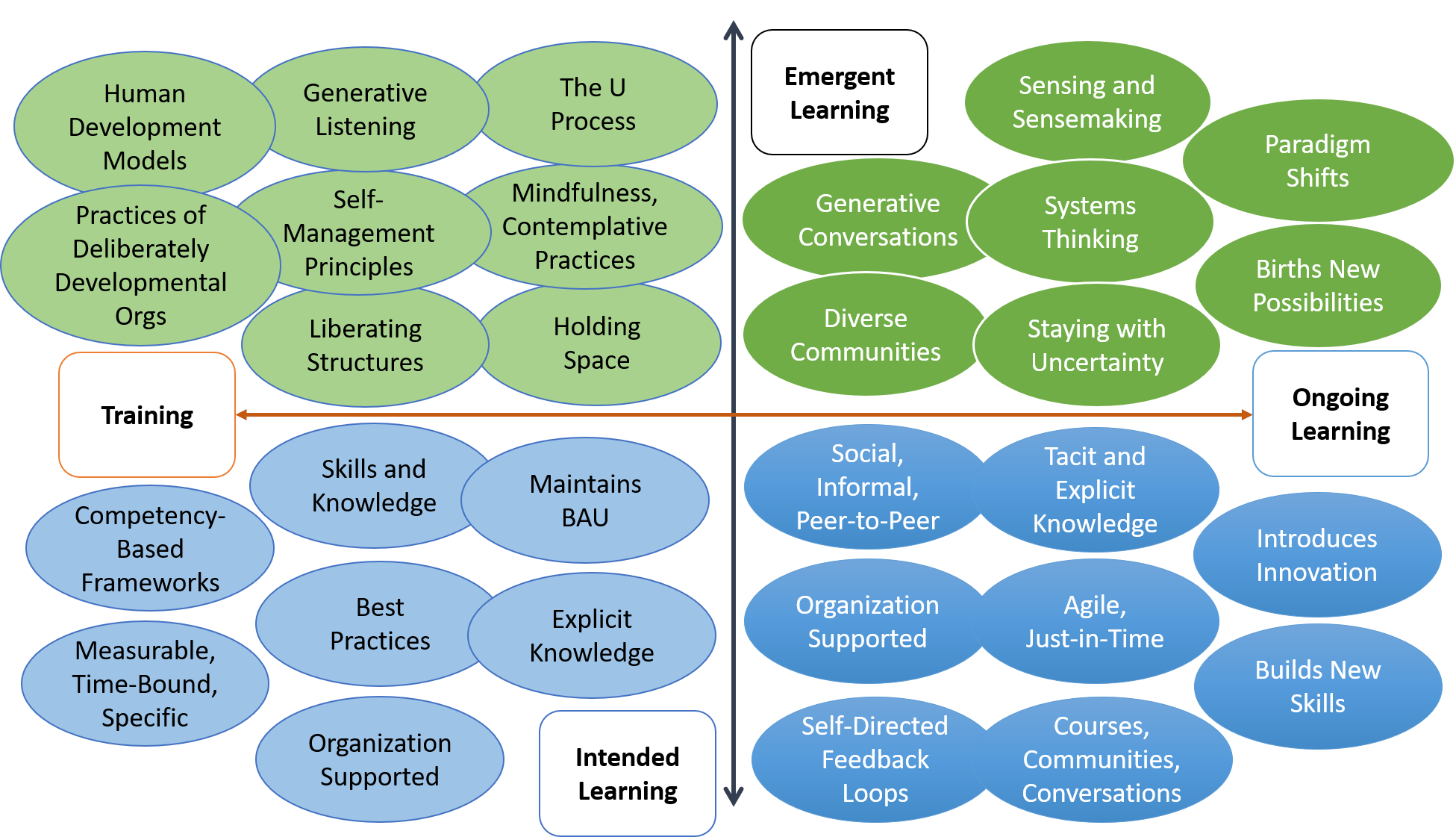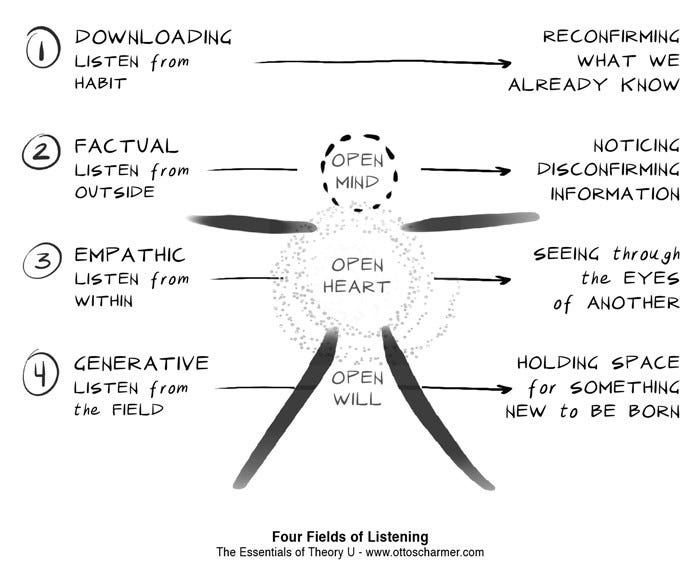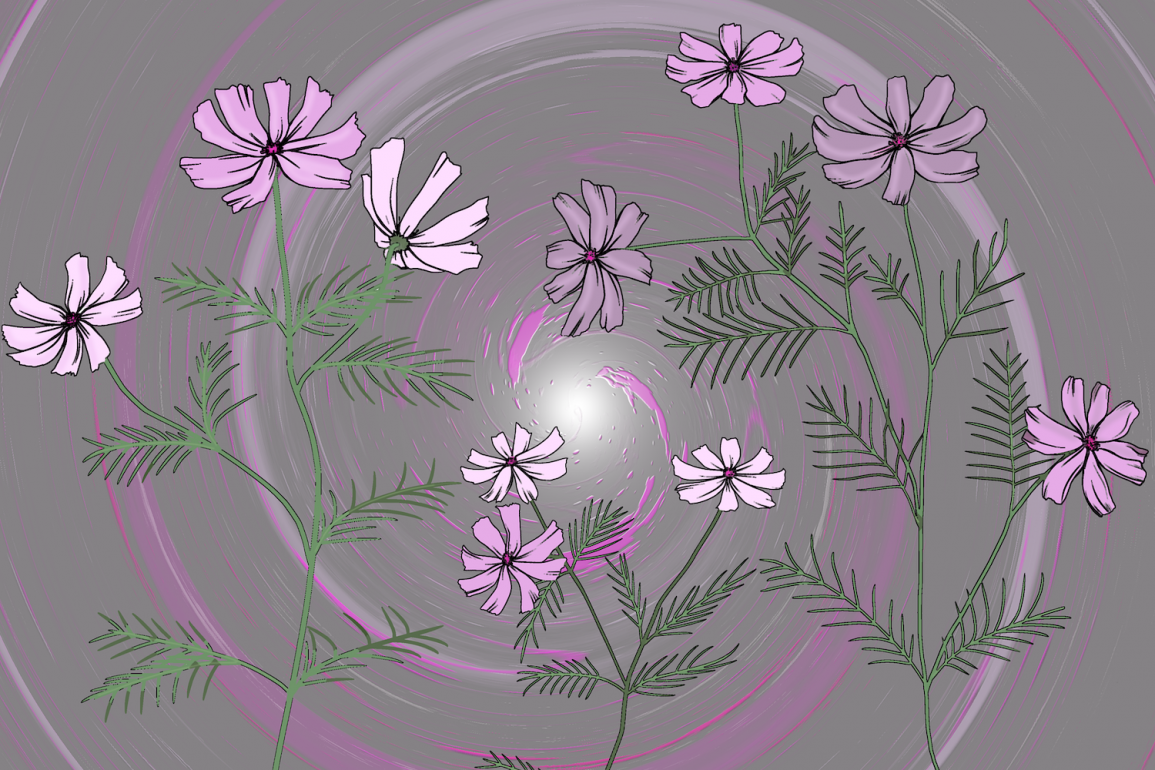By Sahana Chattopadhyay and originally published on medium.com
In transformative learning, the emphasis shifts from information to imagination, from intended learning to emergent learning. ~ Aftab Omer
Complexity, emergence, ambiguity, transformation, agility, etc., are words that have become more and more mainstream over the past few years. VUCA and #futureofwork are commonplace memes now.
Organizations are trying to play catch-up as waves of technology take over our lives, work, attention, and energy. The human mind cannot keep pace with this change. Organizations are merely reflecting the confusion each one of us feels. There’s a scramble to “keep learning” — new skills, new technology, new business processes, new ways of interacting with the customers/consumers/co-creators.
The learning curve seems endless; exhaustion and cynicism are replacing enthusiasm and enquiry. Fear of losing jobs to AI and Robots appear to be rapidly becoming a reality. Gallup’s Employee Engagement report is now well-known.
What has all of this got to do with Organizational Learning? A great deal, I would say. And most organizations recognize this is critical; hence, the growing popularity of terms like “collaborative learning,” “continuous learning,” “agile learning,” “lifelong learning,” and so on.
Against this backdrop of incessant change, advent of the uber-technology era, climate crisis, and socio-political upheaval, I would like to propose that organizations have to learn but learn differently.
I propose a shift to “Transformative Learning.” This enfolds other forms of learning within itself but adds another dimension to the whole.
Transformative Learning goes beyond the cognitive to integrate the heart, gut, body, and intuition.
It is now scientifically proven that our gut and heart also have brains of their own, and send us critical information. However, our cognitive side is so over-developed that we habitually ignore what our heart is telling us and overlook our gut feel, often to repent later. Neither of these forms of sensing and sensemaking find a place in our current organizational setup. And this is to our detriment.
Going back to the quotation above from Aftab Omer, there are two pieces which I feel are critical to shift from regular ways of learning to transformative learning — from information to imagination and from intended learning to emergent learning. For an in-depth understanding of Omer’s perspective, I recommend his article, Imagination, Emergence, and the Role of Transformative Learning in Complexity Leadership.
In this piece, I’ll focus on the two aspects italicized above — imagination and emergent learning — and their relation to Transformative Learning.
I have tried to capture the Organizational Learning shift that I am speaking about in a diagram below:

The lower two quadrants of the diagram illustrate the different forms of learning that typically take place in organizations today — this is Intended Learning.
This kind of learning is based on information, knowledge (from the past), skills and competencies needed for the present, and learning programs designed to tackle the rise of new technology in the future.
This happens through specific Training and different modes of Ongoing Learning supported by the organization and also driven by the learners themselves.
This learning is crucial in maintaining business-as-usual, gives the organizations its competitive edge, helps to build new skills, and give rise to innovation. This kind of learning is perfect during conditions of stability and gradual change.
But not when change is exponential, continuous, and ambiguous. When there are complete paradigm shifts and the world has to be re-envisioned. When the way we see ourselves and our relationship with the world around us need to be re-imagined. I recommend listening to this video by Tomas Bjorkman for a deeper understanding of these shifts.
To deal with these shifts, we need to move from intended learning to emergent learning.
Intended learning happens from a place of knowing and against a set of specific goals. Emergent learning happens from a place of reflection and sensemaking.
In the upper two quadrants of the diagram above, I have shown some of the capacities and conditions necessary for emergent learning to take place. These are still very nascent ideas that I am mulling over even as I write.
Imagination — In these times of Volatility, Uncertainty, Complexity, and Ambiguity, Imagination has a key role to play. I do not mean wild imagination here but the ability to envision possible futures even though the present situation is far removed from that possibility. (Man’s landing on the Moon was imagination once.)
This kind of Imagination is a skill that requires honing and deliberate practice. It is aspirational in nature, sees and envisions new possibilities, and gives voice to what is wanting to emerge. (I have capitalized “Imagination” to distinguish it from imagination or wild flights of fancy and daydreaming.)
Sensing and Sensemaking — The ability to “sense” is rooted in deep, non-judgmental, unbiased observation, feeling with all our senses, and the capacity to step back to see the connection between seemingly disparate situations, contexts, or challenges.
“Sensemaking” is where Imagination and Sensing come together. It requires a leap of faith coupled with all that has been seen, heard, felt, and intuited. IMHO, in the VUCA world, organizations can no longer thrive without Imagination.
Negative Capability — John Keats, the Romantic Poet, wrote about Negative Capability. And the words are as applicable today as they were during his times. I wrote a detailed post about it here, but I will repeat Keats’ quote:
“The concept of Negative Capability is the ability to contemplate the world without the desire to try and reconcile contradictory aspects or fit it into closed and rational systems. …I mean NEGATIVE CAPABILITY, that is when man is capable of being in uncertainties, Mysteries, doubts, without any irritable reaching after fact & reason…” ~ John Keats
Negative Capability, as described by Keats, is a component of Imagination where we are willing to suspend judgement and immerse ourselves in the situation without a need to resolve it.
If one can stay long enough with uncertainty and ambiguity, it is possible to reach a deeper place of knowing from where a more suitable and elegant solution emerges.
I can think of no better capability to be cultivated, nurtured, developed, and honed in today’s organizations.
Holding of Paradox — In our binary, “either this or that” approach, we forget to explore the space in between, the spectrum that holds all the interesting shades of grey. Or even the space completely outside of the spectrum.
As Niels Bohr said, “the opposite of a profound truth may well be another profound truth.” Staying with a paradox requires us to slow down, listen deeply, and be comfortable with contradiction and ambiguity.
This is not a cognitive skill that one can learn from a training program or by reading a book. Its an inner state that needs to be cultivated with curiosity, patience, and perseverance.
Not seeking Closure — The human brain has a deep-seated need for closure. We cannot live with incomplete stories. And this very human pattern plays out in organizational decision making, and especially so when there is acute pressure to adhere to a timeline.
Yet, this is often the enemy of deep, transformative learning and keeps us stuck in our old patterns, repeating the same mistakes, and facing the same crisis. This requires us to train our minds and hearts to stay open, and cultivate curiosity, courage, and compassion. Otto Scharmer’s Theory U is a powerful process that can help organizations move towards building “Negative Capabilities”.
Letting go of Linear Logic — The scientific, mechanistic, Industrial Era has essentially built in us a love for linear cause and effect. However, the complexity of the VUCA world no longer lends itself to linearity; instead we live in a world where “everything is connected to everything else”.
This requires us to step back, widen our perspectives, let go of our need for closure, and sense into the bigger patterns at play. This calls for us to hone our pattern-sensing skills, look beyond immediate connections, and stay with a situation in a mode of open observation.
Holding Space for Self and Others — Holding space calls for us to stay in a facilitation mode — one that is characterized by openness, non-judgement, an awareness of one’s inner state, and an ability to listen deeply.
Organizations today are characterized by speed, efficiency, and accuracy. However, as I have written earlier, complexity and uncertainty require us to slow down. It requires us to go from rapid-fire action to observation, reflection, and thoughtful response when the time is right.
Again, this is not a cognitive skill that can be acquired over a couple of training sessions. This is an inner state of being where we learn (gradually) to slow down, become mindful, and aware. And it takes relentless practice, support, and working with other individuals on the same journey.
Generative Conversations — Otto Scharmer speaks about Four Levels of Listening that leads to Four Levels of Conversation. Those who are Coaches and Facilitators know the importance of Listening at Levels 3 and 4 (refer to diagram below).
It is Empathic and Generative Listening that hold and create space for something new to be born. This kind of listening is rarely practiced in organizations. However, it is precisely this that can truly transform organizations and the individuals who are collectively taking this journey.

Because none of the capabilities mentioned above fall within the typical parameters of tangible, quantifiable, and measurable, they fall off the organizational radar. It’s well-nigh impossible to measure inner growth. Organizations desiring to step onto the path of Transformative Learning need to let go off the old paradigms, and embrace the new in the space of learning.
In the next part of this post, I will write about some Processes, Frameworks, and Methods that organizations can adopt and embed as part of their culture as they undertake to reinvent their learning journey.
This is necessary to build the capacities necessary to lead transformation and operate as a Next Stage Organization. (Refer to Frederic Laloux’ Reinventing Organizations for an explanation of Teal and Next Stage Organizations).
 Sahana is a Coach, Facilitator, Speaker, and Writer with a background in designing workplace learning experiences, and Organization Development.
Sahana is a Coach, Facilitator, Speaker, and Writer with a background in designing workplace learning experiences, and Organization Development.
Catalyst | Community Steward | Scribe to an emerging era… Exploring new ways of Being | Lover of mountains, rivers, forests, & seas.
Her passion is to help individuals, teams, and organizations hold space for emergence, and move towards their fullest potential. Reach her at [email protected]
Featured image/graphic link, block quoting and some paragraph spacing added by Enlivening Edge Magazine. Image by





Sahana, I so deeply appreciate how you take such a variety of complex ideas and weave them into understandable and practical applications. Thank you for your leadership in bringing forth this much needed perspective of Transformative Learning. I would love to see these concepts further developed and implemented in organizations. In Joy
Congratulations for this map. It helps broaden the frameworks of organizational learning. Thank you, beautiful job!